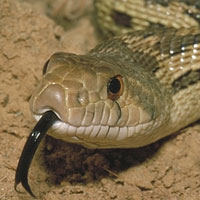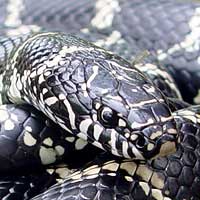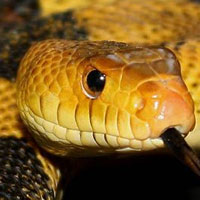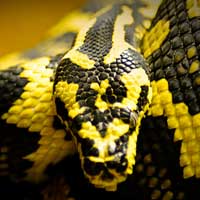Everything You Need to Know About the Solomon Island Coral Snake
The Solomon Island Coral Snake (Salomonelaps par) belongs to the Elapidae snake family, which includes highly venomous species equipped with fixed front fangs and potent neurotoxic venom.
Scientific Name: Salomonelaps par
Snake Family: Elapidae
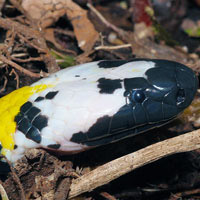
An Overview of the Solomon Island Coral Snake
The Solomon Island Coral Snake (Salomonelaps par) is a highly elusive and venomous snake found primarily in the Solomon Islands. Known for its vibrant coloration, featuring alternating bands of red, black, and yellow, this coral snake serves as both a warning to predators and a key feature of its unique beauty. Despite its striking appearance, the Solomon Island Coral Snake is shy and secretive, preferring to stay hidden in dense vegetation or under forest debris. Its venom, while potent, is rarely encountered due to the snake’s reclusive nature, but it plays a critical role in controlling the populations of small reptiles and amphibians in its ecosystem.
Where Does the Solomon Island Coral Snake Live?
The Solomon Island Coral Snake inhabits the lush, tropical environments of the Solomon Islands, where its adaptive behavior helps it thrive. Key habitat details include:
- Geographic Range: Found exclusively in the Solomon Islands, with sightings primarily on larger islands such as Guadalcanal and Malaita.
- Preferred Environments: Dense rainforests, mangroves, and areas with ample leaf litter.
- Climate: Tropical climates with high humidity and consistent rainfall.
The snake often shelters under logs, rocks, or within dense foliage to avoid predators and extreme weather. Its natural camouflage allows it to blend seamlessly with its surroundings. Below is a table summarizing its habitat preferences:
| Habitat Feature | Description |
|---|---|
| Geographic Range | Solomon Islands |
| Preferred Terrain | Rainforests, mangroves |
| Climate | Tropical and humid |
What Does the Solomon Island Coral Snake Eat?
The Solomon Island Coral Snake is a carnivorous predator with a diet specialized for its habitat. Key dietary information includes:
- Primary Prey: Small reptiles, including lizards and geckos, which are abundant in its environment.
- Occasional Prey: Amphibians, small mammals, and insects.
- Hunting Strategy: Relies on stealth and camouflage to ambush prey, delivering a venomous bite to immobilize it quickly.
The Solomon Island Coral Snake’s diet helps regulate populations of smaller animals, maintaining a balanced ecosystem. Its role as a predator underscores its importance in the local food chain.
Understanding the Behavior of the Solomon Island Coral Snake
The Solomon Island Coral Snake is known for its reclusive and non-aggressive nature. Key behavioral traits include:
- Activity Patterns: Primarily nocturnal, becoming active during the cooler hours of the evening and night.
- Defensive Behavior: Rarely confrontational but will flatten its body and display its vivid coloration when threatened.
- Social Behavior: Solitary, except during the mating season.
Its shy nature means encounters with humans are rare, but understanding its behavior can help ensure safe coexistence. Recognizing its warning displays can help avoid potential danger.
Health and Lifespan of the Solomon Island Coral Snake
The Solomon Island Coral Snake is a resilient species, but it faces several challenges to its health and survival. Important details include:
- Lifespan: Typically 10-12 years in the wild, with longer lifespans observed in captivity under optimal care.
- Health Risks: Habitat destruction due to deforestation and climate change is the primary threat to its survival.
- Predators: Birds of prey, larger snakes, and introduced species such as feral cats.
Efforts to conserve the rainforests and educate local populations about the ecological importance of this snake are crucial to its long-term survival.
How Does the Solomon Island Coral Snake Reproduce?
The reproductive habits of the Solomon Island Coral Snake are key to its population stability. Key details include:
- Mating Season: Typically occurs during the rainy season, when conditions are ideal for supporting offspring.
- Reproductive Method: Oviparous, meaning females lay eggs that hatch outside the body.
- Clutch Size: Lays 6-12 eggs, depending on the female’s size and health.
- Hatchling Behavior: Newly hatched snakes are independent and venomous, capable of hunting small prey immediately.
Understanding its reproductive behavior helps emphasize the importance of protecting breeding habitats to support future generations of this unique species.
Safety Guidelines for Handling the Solomon Island Coral Snake
Handling the Solomon Island Coral Snake requires extreme caution and professional expertise. Key safety measures include:
- Always use specialized equipment such as snake hooks and secure containers for transport.
- Wear protective gloves and boots to minimize the risk of envenomation.
- Ensure enclosures replicate the snake’s natural habitat and are escape-proof.
- Keep antivenom readily available and have an emergency response plan in place.
Due to its venomous nature, interactions with this snake should be left to trained professionals. Education about its ecological role can help foster coexistence while ensuring safety for both humans and the snake.
Disclaimer
The information provided in this article is for educational purposes only. SnakeEstate strongly advises against handling or interacting with venomous snakes, such as the Solomon Island Coral Snake, unless you are a trained and licensed professional. These snakes pose significant risks, and improper handling can result in serious injury or death. Always adhere to local regulations and prioritize safety when dealing with wildlife.
Other Snakes In This Species
 Asp Viper
Asp Viper Black Mamba
Black Mamba Boomslang
Boomslang Brazilian Coral Snake
Brazilian Coral Snake Bushmaster
Bushmaster Coastal Taipan
Coastal Taipan Common Death Adder
Common Death Adder Common European Adder
Common European Adder Copperhead
Copperhead Coral Snake
Coral Snake Cottonmouth
Cottonmouth Eastern Brown Snake
Eastern Brown Snake Eastern Diamondback Rattlesnake
Eastern Diamondback Rattlesnake Egyptian Cobra
Egyptian Cobra Fer-de-lance
Fer-de-lance Forest Cobra
Forest Cobra Indian Cobra
Indian Cobra Inland Taipan
Inland Taipan Jameson’s Mamba
Jameson’s Mamba King Cobra
King Cobra Lancehead
Lancehead Lataste’s Viper
Lataste’s Viper Malayan Krait
Malayan Krait Mojave Rattlesnake
Mojave Rattlesnake New Guinea Small-eyed Snake
New Guinea Small-eyed Snake Nose-horned Viper
Nose-horned Viper Puff Adder
Puff Adder Russell’s Viper
Russell’s Viper Saw-scaled Viper
Saw-scaled Viper Solomon Island Coral Snake
Solomon Island Coral Snake South American Rattlesnake
South American Rattlesnake Tiger Snake
Tiger Snake Western Diamondback Rattlesnake
Western Diamondback Rattlesnake



